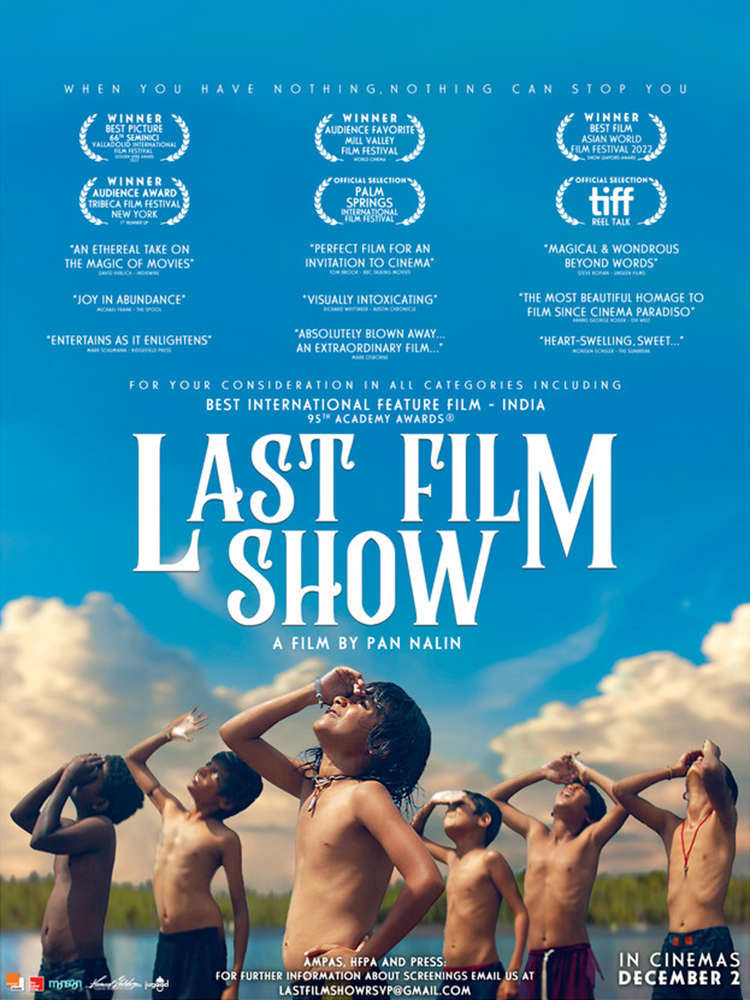05 Feb Last Film Show [India]
Released 2021
SUNDAY 19 MAY 2024 – 10.00 am
TUESDAY 21 MAY 2024 – 8.15 pm
RUNNING TIME 112 minutes
Synopsis:
A young boy in rural India discovers the joys of the movie theatre just as digital projection changes the game. Nine-year- old Samay is a pint-sized wheeler-dealer, a wily old soul and bit of a mechanical genius. This young protagonist’s obsession with the big screen begins with a family visit to the local cinema.
Review: Nadine Whitney
There has recently been a slew of directors reminiscing on their experience with cinema and art how it shaped them. From Spielberg’s self-lacerating The Fabelmans, to James Gray’s ‘portrait of the artist as a young man’ Armageddon Time, to Sam Mendes’ wildly misguided Empire of Light.
Pan Nalin’s Last Film Show uses an avatar of himself, a nine-year-old boy named Samay (Bhavin Rabari) who breathes cinema despite the disapproval of his Brahmin father Bapuji (Dipen Raval) a chai seller on a dying rail station who views cinema as something beneath his family’s caste.
Nevertheless, one day Bapuji takes Samay and his family to a nationalist film at the Galaxy Theatre where Samay realises that his eye has always been cinematic. A child who runs wild on the train tracks using broken bottles as coloured gels through which to view the world is given the medium through which he can express his fascination with light and composition. Soon Samay is skipping school and sneaking into the cinema and forms a transactional based friendship with the cinema’s projectionist Fazal (Bhavesh Shrimali) who teaches Samay about film and editing in exchange for the mouth-watering food Samay’s mother Ba (Richa Meena) prepares for her family.
The setup of course echoes the classic Cinema Paradiso but Nalin’s film is in no manner a clone of that wondrous film. It is specifically his, and specifically Indian. Nalin chose to set the film in 2010 because it heralded a seismic shift in how cinemas in India presented their films. Soon to be assigned to the dust bin of history were the massive spool film projectors and digital projection would become the norm. In part it is an elegy to a lost format and a commentary upon how India is now more split in terms of class via whether people speak English or not. Fazal will become irrelevant, just as Bapulji’s business will die as India modernises and Gujarat (the province where Samay and his family live) changes the way it is connected to metropolitan India.
Last Film Show is inevitably a “love letter to cinema” – although that descriptor seems to be tired and often misused. It is also a gorgeous coming of age story, a heist film, a triumph of adventure and invention. Samay, a natural storyteller, who had previously used brightly coloured Indian match boxes to captivate his wild coterie of friends steals old reels of films and creates a makeshift cinema of his own (these scenes are magical) as well as recreating the myriad of films he has seen via playing and “directing” his little gang.
Samay pays for his transgressions such as skipping school and being chased by the authorities over stolen film stock with harsh beatings from his father. Yet nothing will deter the young boy who “wants to be movies” – his rebellion is that of one who must find his voice regardless of the cost.
Nalin’s work is sentimental and based in a gritty reality. He does nothing to sugar coat Samay’s family’s poverty and their tenuous existence. What he does with the gorgeous cinematography of Swapnil S. Sonawane is recognise the inherent beauty of rural India and how the daily rituals such as cooking and running to catch the train or playing by a lake are shimmering moments that can be ecstatic despite the difficulties the community faces.
“The future belongs to storytellers,” Samay’s teacher Mr Dave says. India that has lost part of its identity due to industrialisation, but it is kept alive and vital through a film industry that rivals Hollywood. Not only did India produce auteurs such as Satyajit Ray, it created Bollywood which through its specific cultural genre mashes is endlessly profitable and recognisable. Nalin clearly loves everything from Bollywood, to Buster Keaton (there is a wonderful tribute to Keaton in the film), Sergio Leone, and a list of directors he credits within the film by name – including Jane Campion, Maya Deren, Charlie Chaplin, Stanley Kubrick, Francis Ford Coppola, Andrei Tarkovsky, David Lean, Věra Chytilová, and Martin Scorsese.
It is rare for a film to be such a heady and sincere journey into the world of movie magic and also keep its feet on the ground. Fazal is a projectionist who thinks cinema is a lie. He isn’t concerned with its transformative power, for him it is a job. For Samay and his small village it is something that can create a complete community as they create their own picture house in uninhabited ruins using materials they have scavenged through scrap yards. No sound? No problem. Have the children create the foley and dialogue. No working projector? A sewing machine will suffice. No light? A torch and a water filled lightbulb can filter the images.
Last Film Show is sincere, and despite some sentimental contrivances, it glows with adoration for what the medium of film means for so many. Pan Nalin’s splendid work is funny, melancholy, and inspiring. The Last Film Show is a wondrous addition to the canon of films celebrating films and will have you cheering for young Samay and his passion to find the light.
Source: www.thecurb.com.au – Nadine Whitney 8/9/2023 Edited extracts accessed 1/1/2024



